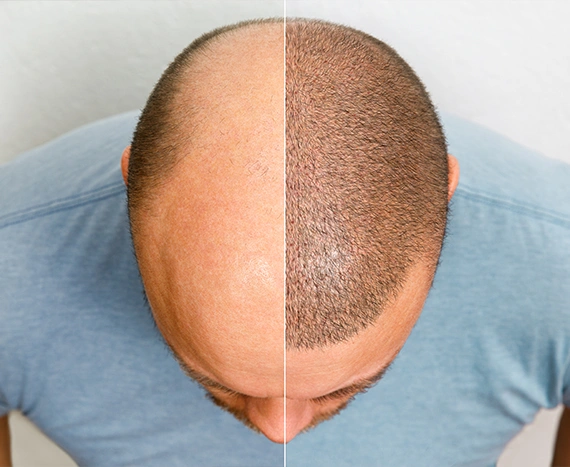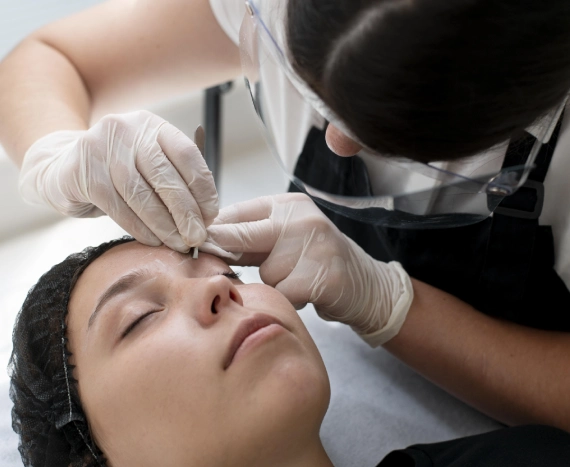
HAIR TRANSPLANT
Millions of people around the world men and women alike suffer from hair loss. Whether it’s caused by heredity, medical conditions, medications, or some other trauma, losing some or worse, all of the hair from your scalp can be very difficult to come to terms with. A full head of hair is seen as a sign of youth and virility. Hair loss can be a tremendous blow to your self-image, and can have a negative effect on the way others perceive you. This is unfortunate, but true.
While you’ll see numerous shampoos, creams, and other advertised remedies for hair loss, once a hair follicle is destroyed, nothing can regenerate it. It’s like any other organic tissue. Once it dies, that’s it. If you suffer from hair loss and you want to regain your thick, full head of hair, it may be time to consider a hair transplant.
What Causes Hair Loss
We all shed approximately 70 to 100 hairs from our scalp daily. This is a normal process that makes room for new, healthy hair to grow in. However, some people begin to experience accelerated hair loss, which leads to a thinning of the hair on the scalp, and can eventually result in total baldness. For many people both men and women this is a blow to their self-esteem and confidence.
This kind of hair loss happens when the hair growth cycle is disrupted, or when the hair follicles are destroyed somehow, and replaced with scar tissue. Hair loss can also be related to:
- heredity (family history)
- medical conditions (hypothyroidism, lupus, and others)
- hormonal changes (sometimes related to pregnancy)
- medications (including chemotherapy treatment for cancer)
It’s important to note that while it’s men who most often suffer from hair loss, it also affects many women. If it’s a hereditary trait, it usually appears later in life, but can occur at any time.


How is a Hair Transplant Performed.?
First, we’ll ask you to come in for a consultation so the doctor can examine your scalp, discuss your concerns, preferences, and expectations, and recommend the right approach for you.
For several days prior to your hair transplant, you’ll need to stop using any medications that might result in excessive bleeding. Your surgeon will be able to provide guidance here. You’ll also need to refrain from smoking and drinking alcohol, both of which can cause your hair transplant to fail.
At Artes Radiance, hair transplants are performed on an outpatient basis, which means you can go home the same day. First, your scalp will be gently shampooed, and then treated with an antibacterial agent to help prevent infection. Then, we’ll administer a local anesthetic to the areas to be treated.
Hair grows in follicles that contain groups of one to four hairs each. These are called follicular units. The technical term for a hair transplant is follicular unit transplantation. Before they can be moved to the target area, these donor units must first be harvested. This is performed in one of two ways:
Strip Harvesting FUT
We’ll administer a local anesthesia to the identified donor area. Next, your surgeon will remove a strip of scalp, usually from the back of your head, where hair often grows more densely. The strip usually measures about 1–1.5cm x 15–30cm. Then the wound in this donor area is sutured using a method called Trichophytic closure, which results in much finer scars at the donor area. The scar may eventually be covered by new hair growth.
Next, the scalp strip is cut into smaller pieces of tissue called grafts, which are transplanted to the target area. The surgeon then uses very small micro blades or fine needles to puncture the target sites. He will then place the grafts in a predetermined configuration, and angle the wounds in a consistent fashion to promote a realistic hair growth pattern.
The recovery period is approximately two weeks, and will require that you return to the clinic to have the sutures removed.


Follicular Unit Extraction or FUE Harvesting
In this method, local anesthesia is administered, and individual follicular units measuring between 0.6mm and 1.25mm in diameter are removed. Then, each follicular unit is inserted into the target area of the scalp using a micro blade.
Follicular unit extraction facilitates the use of a transplantation method called dense packing, which allows more than 50 grafts to be placed per square centimeter, resulting in thicker, fuller hair.
Because individual follicular units are removed through small punctures, scarring and post-surgical pain are both minimized. In addition, because there are no sutures to remove, the recovery period is shorter, lasting approximately seven days.
With both methods, your surgeon will prescribe antibiotics to help prevent wound or graft infections. If you experience any pain, an over-the-counter medication such as acetaminophen (Tylenol) should be sufficient to alleviate discomfort.
Hair Transplant Recovery
After the procedure, your head will be dressed in semi-permeable bandages to allow blood and tissue to drain, which will help keep your scalp from swelling. These bandages will need to be changed daily.
Depending on the outcome of the procedure, your surgeon may recommend that you shampoo the day after your hair transplant. This is to keep scabs from forming around the hair shaft, which can increase the risk of losing newly transplanted hair during the first seven to ten days following surgery.
You must protect the treated area from sun exposure. If you need to be outside, even for a short period, we highly recommend you wear a hat. During the first ten days after your hair transplant, most or possibly all of the transplanted hairs will fall out. This is called shock loss, and it’s completely normal. It’s a result of the hair being traumatized by its relocation.
After a couple of months, you’ll see new hair growth from the relocated follicles. Over the next six to nine months, your hair will begin to grow normally, and will continue to thicken
You may eventually see additional hair loss from areas not included in the hair transplant. You may choose to treat this subsequent hair loss with medication, or plan for another hair transplant in the future.
